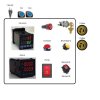I would like to put together a small control panel to run a BIAB setup. The setup I am wanting to do however is not conventional. I want to incorporate a small heat exchanger in order to produce just in time hot water in order to sparge with once the basket has been lifted. That being said, i will have a second heating element, and thermocouple.
keeping in mind that i want to try to keep the control panel as small and simple as possible, is there any way to do this with a single PID/SSR/Contactor? I would like to just be able to throw a three way switch to select which element to turn on, as i do not need them both on at the same time. I will probably have to manually switch the thermocouple wires. (TC2 on the picture is mainly just store the thermocouple not in use)
keeping in mind that i want to try to keep the control panel as small and simple as possible, is there any way to do this with a single PID/SSR/Contactor? I would like to just be able to throw a three way switch to select which element to turn on, as i do not need them both on at the same time. I will probably have to manually switch the thermocouple wires. (TC2 on the picture is mainly just store the thermocouple not in use)































![Craft A Brew - Safale S-04 Dry Yeast - Fermentis - English Ale Dry Yeast - For English and American Ales and Hard Apple Ciders - Ingredients for Home Brewing - Beer Making Supplies - [1 Pack]](https://m.media-amazon.com/images/I/41fVGNh6JfL._SL500_.jpg)


























